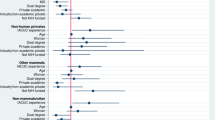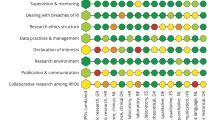Abstract
During the past several decades, society has become increasingly concerned about the welfare of animals used in research. Today, the public asks scientists to justify the use of research animals and to be accountable for their welfare. Research institutions, government bodies and other regulatory authorities have developed mechanisms to ensure that researchers follow the principles of the 3Rs and use and care for research animals in an ethical manner. Additionally, organizations such as the Association for Assessment and Accreditation of Laboratory Animal Care International (AAALAC International) have developed voluntary programs that can help researchers to ensure that they are caring for research animals appropriately. The author discusses how AAALAC International uses performance standards to evaluate the ethical review processes of European institutions.
This is a preview of subscription content, access via your institution
Access options
Subscribe to this journal
We are sorry, but there is no personal subscription option available for your country.
Buy this article
- Purchase on Springer Link
- Instant access to full article PDF
Prices may be subject to local taxes which are calculated during checkout
Similar content being viewed by others
References
Guillen, J. Europe and AAALAC International: some historical facts. LAVA & ESLAV Briefing 12, 19–20 (2009).
EEC. COUNCIL DIRECTIVE of 24 November 1986 on the approximation of laws, regulations and administrative provisions of the Member States regarding the protection of animals used for experimental and other scientific purposes (86/609/EEC). Official Journal of the European Communities L358, 1–29 (1986).
Smith, J.A. et al. Principles and practice in ethical review of animal experiments across Europe: summary of the report of a FELASA working group on ethical evaluation of animal experiments. Lab. Anim. 41, 143–160 (2007).
Institute for Laboratory Animal Research. Guide for the Care and Use of Laboratory Animals (National Academies Press, Washington, DC, 1996).
Bayne, K.A. & Martin, D.P. AAALAC International: Using performance standards to evaluate an animal care and use program. Lab Anim. (NY) 27, 32–35 (1998).
Bayne, K.A. & Miller, J.G. Assessing animal care and use programs internationally. Lab Anim. (NY) 29, 27–29 (2000).
AAALAC International. Reference Resources (AAALAC International, 2009). http://www.aaalac.org/accreditation/resources.cfm.
AAALAC International. Issue Brief: Suggestions for Improvement (SFIs). (AAALAC International, 2007) http://www.aaalac.org/publications/AAALAC_i-brief_SFIs.pdf.
Klein, H.J. & Bayne, K.A. Establishing a culture of care, conscience, and responsibility: addressing the improvement of scientific discovery and animal welfare through science-based performance standards. ILAR J. 48, 3–11 (2007).
AAALAC International. AAALAC International in Europe: Approaches to an Ethical Review. Rome, Italy; 4 May 2009.
Commission of the European Communities. Proposal for a directive of the European Parliament and of the Council on the protection of animals used for scientific purposes. COM(2008)(543) final, 5 November 2008.
Author information
Authors and Affiliations
Corresponding author
Ethics declarations
Competing interests
The author declares no competing financial interests.
Rights and permissions
About this article
Cite this article
Guillen, J. The use of performance standards by AAALAC International to evaluate ethical review in European institutions. Lab Anim 39, 49–53 (2010). https://doi.org/10.1038/laban0210-49
Received:
Accepted:
Issue Date:
DOI: https://doi.org/10.1038/laban0210-49
This article is cited by
-
Citizens, Consumers and Animals: What Role do Experts Assign to Public Values in Establishing Animal Welfare Standards?
Journal of Agricultural and Environmental Ethics (2015)



